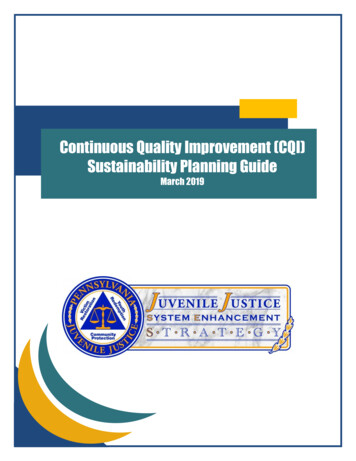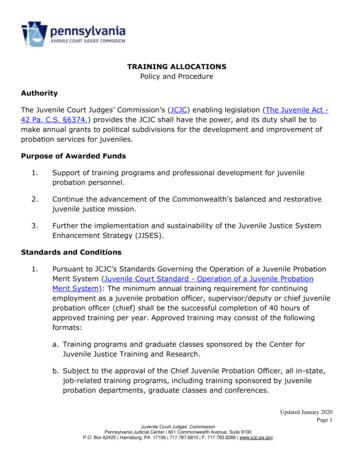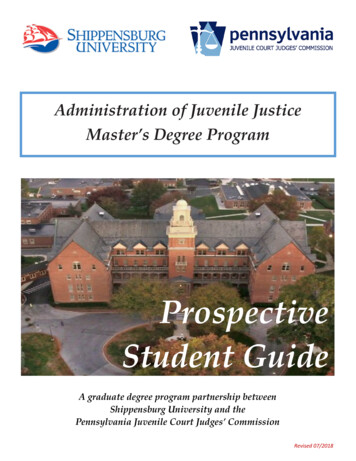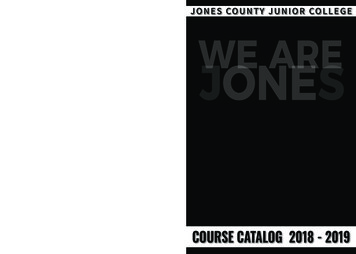
Transcription
March 2019Continuous Quality Improvement (CQI)Sustainability Planning GuideMarch 2019
SPECIAL THANKS AND ACKNOWLEDGMENTThe Continuous Quality Improvement (CQI) Committee represents several different juvenile justiceprofessionals from numerous counties in Pennsylvania, representation from the Pennsylvania Councilof Chief Juvenile Probation Officers (PCCJPO), the Juvenile Court Judges’ Commission (JCJC), andThe Carey Group (TCG). This important initiative could not have been accomplished without thediligence and dedication from all members over the course of two years. It is with the greatestappreciation that the committee members are recognized.Committee Members and Advisors:Nicole Mattern, Chair – Dauphin County Probation ServicesAndrew Backlund – Montgomery County Juvenile ProbationNick Caramenico – Bucks County Juvenile ProbationPamela Farkas – Mercer County Juvenile ProbationMary Gaspari – Chester County Juvenile ProbationLaurie Hague – Berks County Juvenile ProbationCheri Modene – Lancaster County Juvenile ProbationRyan Schaffer – Lehigh County Juvenile ProbationScott Shea – Cumberland County Juvenile ProbationRobert Swanger – Cumberland County Juvenile ProbationAlan Tezak – JJSES Project ConsultantRobert Tomassini – Juvenile Court Judges’ CommissionBill Wiegman – Bucks County Juvenile ProbationTeresa Wilcox – McKean County Juvenile ProbationAngela Work – Juvenile Court Judges’ CommissionProject Consultant:Mark Carey – The Carey Group
TABLE OF CONTENTSChapter 1: Introduction to the Continuous Quality Improvement (CQI)Sustainability Planning Guide .1Chapter 2: Getting Started .8Chapter 3: Motivational Interviewing . 12Chapter 4: Youth Level of Service/Case Management Inventory (YLS/CMI). 16Chapter 5: Pennsylvania Detention Risk Assessment Instrument (PaDRAI) . 23Chapter 6: Case Planning . 32Chapter 7: One-on-One Interventions . 38Chapter 8: Cognitive-Behavioral Interventions . 44Chapter 9: Graduated Responses. 52Appendix 1: Coaching Policy and Practice . 62Appendix 2: CQI Self-Assessment Checklist . 70Appendix 3: Implementing CQI in a Rural Setting . 73Appendix 4: Policies Related to the Observation of Staff–Client Interactions . 74Appendix 5: Case Planning Coaching Checklist . 75References. 76Recommended Reading . 77
Chapter 1: Introduction to the Continuous Quality Improvement(CQI) Sustainability Planning GuideThe Continuous Quality Improvement (CQI) Sustainability Planning Guide is an initiative of theJuvenile Justice System Enhancement Strategy (JJSES). Its goal is to help Pennsylvania juvenileprobation chiefs, as well as those responsible for the development and implementation of qualityassurance, establish a continuous quality improvement plan. While other juvenile justiceprofessionals may find sections of this guide useful for professional growth, it was written with theseaudiences in mind.DEFINING THE TERMSThe terms “quality assurance (QA)” and “continuous quality improvement (CQI)” are often usedinterchangeably. For purposes of this guide, the following distinctions are made: Quality assurance answers the question “Was the activity done?” Quality assurance tends toexamine practices retrospectively to determine if they were conducted.Continuous quality improvement answers the question “Was the activity done well?” Assuch, CQI is a fluid process of planning (defining the goal and activity), implementing theactivity, assessing whether it was implemented in accordance with the plan (by measuring theprocess and outcomes), and adjusting (through modifications to the process, booster sessions,etc.; see figure 1).Figure 1: The CQI ProcessPlanningImplementingAssessingAdjusting1
THE IMPORTANCE OF CONTINUOUS QUALITY IMPROVEMENTThe recent explosion of evidence-based practices (EBP) in juvenile justice has changed probation’sapproach to client management. However, to truly realize the recidivism reduction potential ofcritically important practices such as motivational interviewing, building professional alliance,effective case planning and management, and skill practice using cognitive-behavioralinterventions, staff must be adequately prepared. They must be properly trained, and knowledgeand skills learned in the classroom must be transferred to real-world settings. In addition, CQIprocesses must be put in place to verify whether an agency is doing evidence‐based work, howwell it is doing it, and if it is leading to the desired outcomes. In this way, CQI serves as amanagement tool to reinforce desired practices and ensure fidelity. It connects the dots betweenwhat happens on a day‐to‐day basis and the achievement of desired outcomes.“Drift” can be defined as the process of incrementally departing from an endorsed, provenprocedure. Drift occurs when one is trained in the proper way to execute a skill, assessment, ortool only to depart from the sanctioned approach over time. Without a process to prevent drift, itis inevitable. Assessments will not be done accurately, tools will not be used properly, andtechniques will be misapplied. The process of CQI will uncover areas in which drift has occurred—as well as the gaps in services and processes, policy shortcomings, and lack of resources that havecontributed to the drift—and new areas that need attention. As such, CQI is not the final stage ofJJSES implementation; rather, it leads to constant cycles of discovery, action, improvement, andmeasurement.IMPLICATIONS OF CQI TO THE BALANCED AND RESTORATIVE JUSTICE (BARJ)MISSIONAccording to Advancing Balanced and Restorative Justice Through Pennsylvania’s JuvenileJustice System:The JCJC and Pennsylvania Council of Chief Juvenile Probation Officers created theJuvenile Justice System Enhancement Strategy largely out of recognition that the growthof knowledge derived from research evidence required juvenile justice stakeholders toadapt their practices in order to become more effective at achieving BARJ goals. Thisadvanced state of knowledge caused policymakers and practitioners to examineexisting practices and ask themselves if they aligned with the research evidence. Theresult was a sobering realization that existing practices were often not in alignmentwith research and were often not cost-effective (Blackburn et al., 2015, p. 3).The implementation of CQI enables juvenile probation departments to achieve the mission ofPennsylvania’s juvenile justice system around the BARJ goals:1. Community protection: The public has the right to a safe and secure community. Key toachieving this goal is identifying, managing, and minimizing a youth’s risk to re-offend.Identifying risk requires the use of structured decision-making tools to determine those riskfactors that may contribute to a youth’s delinquent behavior. Managing risk refers to applyingrestrictions, such as curfews or electronic monitoring, to lessen the possibility of delinquentbehavior. Minimizing risk involves using effective interventions to address a youth’scriminogenic needs.2
2. Competency development: Youth should leave the juvenile justice system more capable ofbeing productive and responsible members of their communities. Priority is attached toactivities that build skills, including coping skills, moral reasoning skills, academic skills,workforce development skills, and independent living skills. These skills are best learned whenthey are modeled for youth, practiced by youth, and then demonstrated by youth in a rangeof increasingly challenging situations. Fostering competencies in youth allows them to build ontheir strengths, increase their self-esteem, and reduce behaviors that put them and theircommunities at risk.3. Accountability: Delinquent youth in Pennsylvania incur obligations to their victims and thecommunities they harmed. Victims and communities assume active roles in defining both theharm and the appropriate response. Youth exhibit true accountability by learning about andacknowledging the harm caused by their behavior, actively assuming and fulfilling theirresponsibilities for making reparation, paying restitution, and participating in structuredactivities that benefit the community. Courts and communities support, facilitate, and enforcereparative agreements.ABOUT THIS GUIDEThe guide addresses seven core areas of CQI related to probation services for youth that areessential in order to achieve the BARJ goals. These core areas are not inclusive of all areas; atsome point, consideration should be given to develop a CQI plan for other juvenile justice-relatedactivities. Each of the seven areas listed below potentially impacts multiple parties: youth, families,victims, and/or the community.1. Motivational interviewing: The processes inherent in motivational interviewing (MI) contributeto effective communication skills. MI enhances active listening, collaborative communication,and empowerment, among other areas. MI skills are useful in a juvenile justice setting withyouth, family members, victims, and/or the public. CQI in this area provides practitioners witha means to improve their MI skills in order to enhance communication for all involved.Related BARJ Goals: Community protection, competency development, accountabilityAffected parties: Youth, family, victim, community2. Youth Level of Service/Case Management Inventory (YLS/CMI): Actuarial assessment toolsprovide accurate and useful information to help guide practitioners in knowing what actions totake or which additional assessments to administer. Examples of assessments include risk andneeds assessments and mental health screens for justice-involved youth; victim safetyassessments administered by law enforcement in cases involving domestic violence; andcommunity strength assessments conducted by those involved in prevention. CQI ensures thatassessment tools, such as the YLS/CMI, are administered effectively in order to maintain theirfidelity.Related BARJ Goals: Community protection, competency developmentAffected parties: Youth, family, victim, community3
3. Pennsylvania Detention Risk Assessment Instrument (PaDRAI): The PaDRAI is used toguide decision making about the placement of youth prior to their hearing (i.e., release,alternative to detention [e.g., evening reporting center, shelter placement]) and the diversionof low-risk youth from further penetration into the justice system. As with the YLS/CMI, CQIensures that the PaDRAI is administered effectively in order to maintain its objectivity,uniformity, and reliance on evidence-based risk factors.Related BARJ Goals: Community protectionAffected parties: Youth, family, victim, community4. Case planning: When case plans are developed and managed effectively, risk reduction andvictim and community restoration are more likely. A case plan should reflect an individual’srisk level and address their criminogenic needs, as determined by the assessment; be adjustedaccording to responsivity factors; build on the youth’s strengths; support the youth byengaging family members and the community whenever possible; address the harm caused bythe delinquent act; and support restorative interaction between the youth and victim whenappropriate. CQI assesses the degree to which case plans incorporate these features.Related BARJ Goals: Community protection, competency development, accountabilityAffected parties: Youth, family, victim, community5. One-on-one interventions: Probation officers can reduce re-arrest rates by engaging in skillbuilding activities during their appointments with youth. These interventions, coupled with skillpractice and homework, can have a profound impact on public safety if conducted inaccordance with the research. CQI provides probation officers with coaching feedback toenhance their ability to effectively deliver these interventions to youth.Related BARJ Goals: Community protection, competency developmentAffected parties: Youth, family, community6. Cognitive-behavioral interventions: The most effective interventions designed to reduce rearrests are cognitive-behavioral programs. These programs utilize a structured, manualizedapproach to teach participants prosocial ways of thinking, problem solving skills, social skills,and more. Youth who successfully complete these programs are, on average, less likely toengage in future delinquent activity. This means that the community is better protected, andthe youth is better prepared to live in the community without harming themselves or others.CQI provides a means to ensure that these programs are delivered in the way they wereintended.Related BARJ Goals: Community protection, competency developmentAffected parties: Youth, family, community7. Graduated responses: Effective behavioral responses when youth are compliant (incentives)or noncompliant (sanctions) help guide youth to act responsibly. Risk reduction researchsupports the goals of responding swiftly, fairly, and with certainty, using a ratio of incentivesto sanctions of at least 4:1. CQI processes help ensure that probation staff and the courtsrespond to youth behavior in a manner that is more likely to positively shape future behavior,thereby benefiting all parties impacted by delinquent activity.Related BARJ Goals: Community protection, accountability, competency developmentAffected parties: Youth, family, victim, community4
Each chapter related to one of these areas describes what “good practice” looks like;suggests activities that can be implemented to support the CQI effort; details important policyconsiderations; lists data and performance measures; recommends materials to assist in thefacilitation of CQI around the area; and outlines future considerations. This guide also offersdirection on establishing an overall CQI plan and on implementing a coaching infrastructure.MORE DEFINITIONSFor purposes of this guide, these terms are defined as follows: Criminogenic needs: A youth’s characteristics, traits, problems, or issues that are directlyrelated to their likelihood to engage in delinquent behavior. Risk: The likelihood of committing a future delinquent act. Responsivity factor: An individual trait that may influence how an offender responds toprograms and approaches. Interventions should be tailored to individuals’ responsivityfactors to maximize learning. Strengths: Personality traits, skills, and external supports that lead to accomplishment andself-efficacy. Triggers: A stimulus that has been repeatedly associated with the preparation,anticipation, or execution of a harmful behavior; can be a person, place, or thing. Four-Point Structured Appointment: A structured interaction for a 20-minuteappointment between a probation officer and youth that addresses supervision and riskreduction goals It includes a check-in, a review of past assignments, an intervention, and atake-home assignment.CQI ACTIVITIESThere are a range of activities that a juvenile probation department should consider implementingto ensure high quality in the various CQI areas. These methods should highlight the positive workthat is occurring as well as the areas that might need some more attention. Among the CQIactivities described in this guide are inter-rater reliability testing, whereby multiple people assessthe same case to determine if they arrive at the same score (i.e., a measure to ensure consistentscoring and to ensure that assessors are measuring what they are supposed to measure); thecollection of process and outcome measures to determine if drift has occurred; and theintroduction of various post-training experiences.Every year, juvenile probation departments invest a significant portion of their budget oneducating staff. The most common tool utilized is formal classroom trainings. Classroom trainingassumes that staff will transfer new knowledge and skills to the workplace—that a single eventwill achieve its goal—but experience tells us differently. The probation profession is increasinglydiscovering what other professionals have learned: training by itself does not yield significantbehavioral changes in staff. Post-training experience demonstrates that staff who receive trainingin skills usually fail to apply those skills due to pressing work demands, lack of urgency, lack ofappreciation for the benefit of the new skills to them and/or youth, discomfort in attempting to5
use the skills, lack of confidence in their level of competency, an inability or lack of willingness toreplace old habits with new processes, lack of organizational support, and/or contradictorymessages from management.Training is necessary but insufficient for skills to be transferred from the classroom to the worksetting. Fortunately, research has provided department administrators with a roadmap tosuccessful technology transfer. This research has demonstrated that training followed by coachingservices improves comfort with, competency in, and adherence to the new skills. In a particularlycompelling research study, Joyce and Showers (2002) showed that 95% of new skills wereapplied to the work environment when staff received training, had the skills modeled, practicedthe skill, received feedback after practicing the skill, and received on-the-job coaching. Thiscompares to a 5% transfer of new skills when staff received only classroom training.In a study of corrections professionals, coaching improved the transfer of skills and contributed toreductions in recidivism (Lowenkamp, Robinson, Koutsenok, Lowenkamp, & Pearl, 2012; Robinsonet al., 2012). Face-to-face EBP coaching sessions after initial training increased correctionsprofessionals’ understanding of how to use their newly learned skills on the job and theirlikelihood to apply these skills in their interactions with justice-involved individuals. In fact, clientson the caseloads of corrections professionals who had received training and coaching were 24%less likely to recidivate than those who did not receive training and coaching.The following are among the post-training experiences explored in this guide: Booster trainings, unit or staff meetings, brown bag lunches, and learning teams: Boostertrainings, unit or staff meetings, and brown bag lunches all offer opportunities for continuedlearning. Booster trainings are refreshers on specific topics. These trainings might last a wholeday or a half day, or they might take place for one hour every month. They give participantsthe opportunity to further discuss and practice skills introduced at an initial training, includingthe opportunity to discuss c
The JCJC and Pennsylvania Council of Chief Juvenile Probation Officers created the Juvenile Justice System Enhancement Strategy largely out of recognition that the growth of knowledge derived from research evidence required juvenile justice stakeholders to adapt their practices in ord











